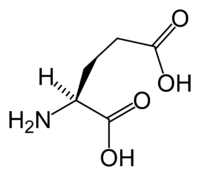
Photo from wikipedia
Epilepsy is characterized by unpredictable recurrent seizures resulting from abnormal neuronal excitability. Increasing evidence indicates that aberrant astrocyte signaling to neurons plays an important role in driving the network hyperexcitability,… Click to show full abstract
Epilepsy is characterized by unpredictable recurrent seizures resulting from abnormal neuronal excitability. Increasing evidence indicates that aberrant astrocyte signaling to neurons plays an important role in driving the network hyperexcitability, but the underlying mechanism that alters glial signaling in epilepsy remains unknown. Increase in glutamate release by astrocytes participates in the onset and progression of seizures. Epileptic seizures are also accompanied by increase of tumor necrosis factor alpha (TNFα), a cytokine involved in the regulation of astrocyte glutamate release. Here we tested whether TNFα controls abnormal astrocyte glutamate signaling in epilepsy and through which mechanism. Combining Ca2+ imaging, optogenetics, and electrophysiology, we report that TNFα triggers a Ca2+‐dependent glutamate release from astrocytes that boosts excitatory synaptic activity in the hippocampus through a mechanism involving autocrine activation of P2Y1 receptors by astrocyte‐derived ATP/ADP. In a mouse model of temporal lobe epilepsy, such TNFα‐driven astrocytic purinergic signaling is permanently active, promotes glial glutamate release, and drives abnormal synaptic activity in the hippocampus. Blocking this pathway by inhibiting P2Y1 receptors restores normal excitatory synaptic activity in the inflamed hippocampus. Our findings indicate that targeting the coupling of TNFα with astrocyte purinergic signaling may be a therapeutic strategy for reducing glial glutamate release and normalizing synaptic activity in epilepsy.
Journal Title: Glia
Year Published: 2018
Link to full text (if available)
Share on Social Media: Sign Up to like & get
recommendations!